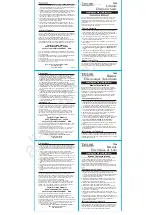
36
eNGLIsh
Information on Body Fat measurement
caution:
Persons using a pacemaker or other medical implant with
electronic parts are not advised to use this scale. The power
output of the implant can be jeopardized, resulting in its
impairment.
Note:
The device can only function correctly if you stand on the
contact surfaces with bare, dry feet!
The main principle of this device is based on the measurement
of the electric impedance within the human body. In order to
determine the actual body data, the device leads a weak, unno
-
ticeable electric signal through your body.
The signal is generally safe! However, please read our special
safety instructions!
The method of measurement is referred to as “bioelectric
impedance analysis” (BIA), a factor which is based on the
relationship between body weight and associated body water
percentages as well as on other biological data (age, gender,
body weight).
There are heavy persons with a well-balanced percentage
between fat and muscle mass, and there are seemingly slim
persons with significantly high body fat values. Fat is a factor
that puts serious strain on the body, in particular the cardiovas
-
cular system. Therefore, controlling both values (fat and weight)
is a prerequisite for health and fitness.
Body Fat
Body fat is an important component of the body. From protect
-
ing the joints as a vitamin repository to regulating the body
temperature, fat plays a vital role in the body. Thus the goal is
not to radically reduce the proportion of body fat, but rather to
achieve and maintain a healthy balance between muscle and
fat.
the Importance of Water for our health
Approximately fifty-five to sixty percent of the human body con
-
sist of water, depending on age and gender in varying amounts.
Water has to fulfill several tasks within the body:
• It is the building block of our cells. That means that all the
cells in our body, whether skin cells, gland cells, muscle
cells, brain cells or others, are functional only if they contain
enough water.
• It is a solvent for important substances in our body.
• It is a means of conveyance for nutrients, the body’s own
substances and metabolic products.
Reference values for your fitness profile can be seen in the
benchmark table. It shows the dependency of body fat data
on age and gender. Always pay attention to your body’s water
balance, which, as well as the fat level, undergoes strong
fluctuations throughout the day. Therefore, to obtain consistent
data, always measure at the same time of day.
The calculated results of the body fat and water level should
only be considered as reference values. They are not recom
-
mended to be used for medical purposes. Please always con
-
sult a doctor if you have questions about a medical treatment or
a diet in order to achieve a normal body weight.
technical Features
Memory capacity:
10
Mass alignment:
from 100 to 220 cm (3‘03” – 7‘03” Ft:in)
Age:
from 10 to 80 years
Minimum weight:
from 2.5 kg (5.5 lb)
Maximum weight:
150 kg (330.7 lb)
Weight measurement unit:
100 g increments
Body fat measurement unit:
0.1 %
Body fat measuring range:
5.0 % - 50.0 %
Body water measuring range:
35.0 % - 85.0 %
Muscle mass measuring range:
10.0 % - 50.0 %
Guideline for Body Fat Amount in Percentage (approximate values)
AGE
(years)
Women
Men
UNDER FAT HEALTHY OVER FAT
OBESE
UNDER FAT HEALTHY OVER FAT
OBESE
10-11
11-13%
14-23%
24-27%
>27%
9-11%
11-20%
21-24%
>24%
12-15
12-15%
16-24%
24-29%
>29%
7-9%
10-19%
20-23%
>23%
16-39
17-20%
21-28%
29-33%
>33%
10-12%
13-20%
21-25%
>25%
40-60
20-23%
23-32%
33-37%
>37%
13-15%
16-23%
24-29%
>29%
61-80
21-24%
25-35%
36-40%
>40%
15-17%
18-26%
27-31%
>31%
















































